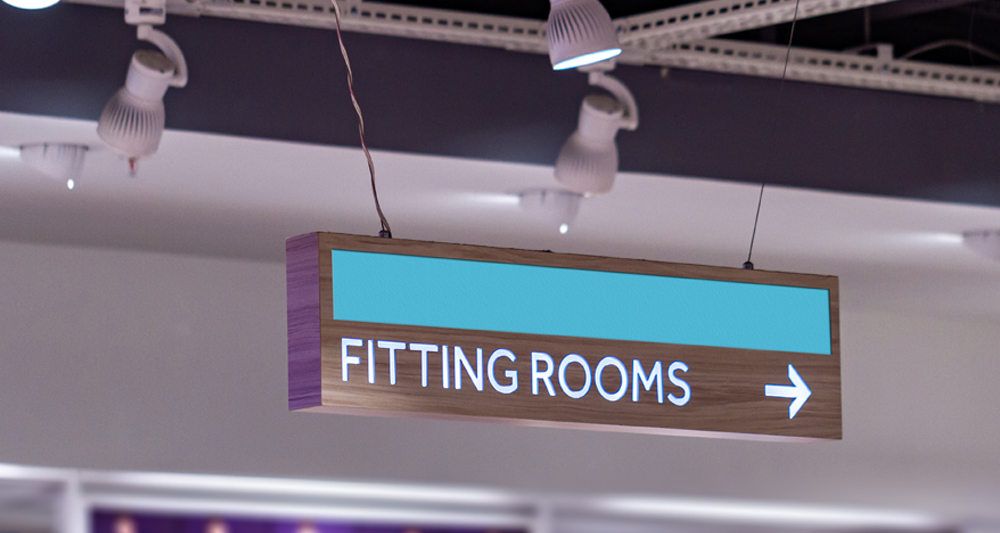The Cyber Age Enters the Fitting Room

December 6, 2019 | By Jeff L. Wright
Researchers: Amaradri Mukherjee, Ronn J. Smith, Anna M. Turri
In Stephen Spielberg’s film, Minority Report (2002), John Anderton (Tom Cruise) is on the run in a “smart” mall. As he passes by, billboards and signs light up, calling him by name and encouraging him to buy products. Inside a retail store, the messages are even more personalized to customers as they are welcomed to the store by name. Even in 2002, most people watching this movie knew that scenes like this would not be science fiction for long. If anything, the film was likely just stoking the fires of the R&D phases of development into this type of smart technology. And the day has finally arrived where a few companies are implementing Radio-Frequency Identification (RFID) technology into retail stores, including smart fitting rooms.
While smart rooms are still somewhat rare in 2019, companies such as Nordstrom and Ralph Lauren have been experimenting with RFID equipped fitting rooms for four or more years now. However, little research has been conducted regarding the effectiveness of this type of smart technology in that time. In a 2018 Journal of Business Research article titled “The smartness paradox: the moderating effect of brand quality reputation on consumers’ reactions to RFID-based smart fitting rooms,” Amaradri Mukherjee, Ronn J. Smith and Anna M. Turri present the results of their own research into this emerging technology. While it comes as no surprise that smart fitting rooms “positively influence consumers’ purchase intention,” it’s a different story when you factor in psychological elements such as customer satisfaction and privacy.
The Research
Mukherjee, Smith and Turri set up their own research lab smart fitting room and took advantage of one of the greatest assets a university can provide researchers: student test subjects. Jeans fitted with RFID tags were taken into the test fitting room and hung on a “smart hook.” A touch screen monitor in the room displayed info about the jeans, then prompted the test subject to enter information for a more personalized experience. Given the numerous recent data security breaches, anyone can recognize the issue that arises here. A customer is likely to have little problem with a screen saying, “Hey, we have these in different colors and they go great with these shirts,” however, when it follows up with, “Give me your measurements and payment information,” that’s where consumers have to weigh the security risks. This balancing out of risks is exactly why these researchers were conducting this study – to understand what motivates, or potentially compensates, a customer to proffer personal information in an age where data theft is a major concern.
High and low-scope cues and brand reputation are a key factors in taking RFID and smart technology to a personalized level for customers. High-scope cues, such as a well-known, major brand name, can offset a customer’s paranoia about low-scope cue elements, such as the warranty information and security disclaimers. Another aspect to test for is whether these cues actually increase sales and customer satisfaction, and, again, high and low-quality branding affected these results in similar ways.
The results indicated that when customers face multiple cues, a high-quality brand name instills more confidence in the low-scope information request, thus affecting the potential for the info request to be filled out by the customer. Low-quality brands don’t instill the same confidence, and therefore customers are less likely to give up personal info. Consider how you might answer an information request in a smart room in Nordstrom or Ralph Lauren vs retailers with questionable reputations. High-quality brands seem to be the only stores which would benefit from smart fitting rooms – to what degree really depends on what the company is doing with the system. Customer satisfaction and purchase intention were definitely enhanced by the implementation of this technology for high-quality brands.
In low-quality brands, this technology was not beneficial. It’s exactly what you would think would be the problem: We’re less likely to give personal information to less credible outfits. These negative perceptions could affect customer satisfaction. This is also where the researchers presented something that we might be skeptical about. They argue that third-party (e.g., FTC) security disclosures will function as a high-scope cue because it’s the Federal Trade Commission issuing the statement. This statement in turn will offset customer apprehension.
While we can probably all agree that such information is readily available personal experience would indicate that a great number of people would be likely to treat FTC security disclosures the same way they ignore end-user-agreements. Mukherjee, Smith, and Turri discovered, however, that in the presence of such FTC information, brand quality was irrelevant in terms of customer satisfaction and security. Their results indicated that people did feel more secure after learning that the FTC audits these establishments and enforce proper security protocols.
How this research affects you as a manager/leader:
In a video on YouTube about Ralph Lauren’s endeavors into smart fitting rooms, Healey Cypher, chief executive officer of ZIVELO, a public computing company, explains and shows how smart fitting rooms work in their stores. I am as skeptical and numb to the amount of new technology as anyone, but even I was taken aback at how much this made me want to shop in one of these stores! On top of that, how cool is it that we can get info about new smart technology from someone named “Cypher?”
Cypher walks us through the perks of their smart fitting room and explains how it essentially doubles as both a customer interface and a tracking system. Ralph Lauren’s rooms bring a lot of online features, such as searches and browsing on a mirror that also functions as a video screen, into the brick-and-mortar retail space. It then tracks what items of clothing go into a dressing room, which ones are being purchased, but probably more importantly to you, which items are not sold. At the end of the day, or even in a few hours, you collect data about what items are selling and what items are not, while your inventory is being updated by the customers carrying the clothes in and out of these smart fitting rooms. Along with that, customers can have clothes brought to the dressing room, opening the door for all levels of service from concierge to get-it-yourself.
For people who shop online, this level of service may be one effective strategy to get them into stores. It combines the convenience of online shopping with the immediate gratification of being able to try on clothes and buy them in-store, instead of waiting for two-day shipping. More customized features will require customers to input personal data such as measurements or a credit card number to buy the items in the dressing room. The only thing that is really a mystery here is who will remove the RFID security tags, or will those become a thing of the past too?
Some of us might remember a time when older people were apprehensive about using an ATM for the first time, and now we live in an age where we get frustrated about how many buttons we have to push to get the money out of them. Now we get annoyed at how many security disclosures and end-user-agreements we have to click through to make the purchase, not to mention regularly giving out banking information to pre-purchase online so we can get our coffee faster in-store.
Despite any potential “Orwellian overreach,” RFID and other smart technology is an inevitable addition to the retail industry. The question in most people’s minds will be whether or not their identity is safe in using some of the more personalized features. For a high-quality brand name company, there is no end to the potential for this type of technology. For lower-quality brands, they will need to offset their customer’s insecurities about personal data with FTC disclosures, which proved to be effective in the test lab fitting room. With RFID technology already being implemented in major retail stores, it won’t be much longer before we know how the population at large reacts to these new ways of shopping. All indications seem to point to smart fitting rooms increasing both sales and customer satisfaction for companies who implement this technology.

